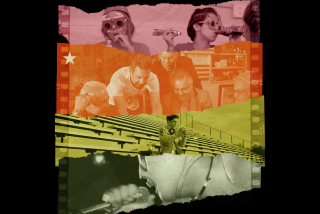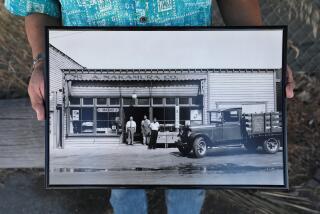L.A.’s ‘Exiles’ revisited
Never released theatrically and all but unseen in the 50 years since shooting began, “The Exiles” is a lost Los Angeles treasure about a culture that disappeared and haunting neighborhoods that are no more. That we have it with us again is little short of miraculous.
Directed by Kent Mackenzie and showing for a week at UCLA’s Billy Wilder Theater in Westwood’s Hammer Museum, “The Exiles” offers a quasi-documentary, cinema verite look at the rootless Native America community that once upon a time lived in Bunker Hill and hung out in downtown bars like Club Ritz, places where shots were 55 cents and Lucky Lager came in cans.
Never seen outside the festival circuit because its sensibility was wildly uncommercial, “The Exiles” sank even deeper into oblivion than its spiritual soul mate, Charles Burnett’s “Killer of Sheep.” It was the persistence and detective work of director Thom Andersen, who used clips from “Exiles” in his extraordinary documentary “Los Angeles Plays Itself,” which led the UCLA Film & Television Archive to do its usual superb job of restoration on the film.
That work is especially valuable because one of the key attractions of “The Exiles” is its luminous black-and-white portrait of a time and a place in the city that can be found almost nowhere else.
Working on less than a shoestring (the original budget was $539), cinematographers Erik Daarstad, Robert Kaufman and John Morrill -- all, like director Mackenzie, affiliated with USC’s film school -- captured a brooding picture of a darkly beautiful, long-gone Los Angeles. We see the houses of Bunker Hill in the days of Angels Flight as well as a lively, brightly lit albeit raucous downtown, home to establishments such as Cooper Do-Nuts and a barber college offering 25-cent haircuts to all comers.
Determined to present an honest portrait of the city’s lost and lonely Native American population and avoid what he called the “romance of poverty,” filmmaker Mackenzie spent many months hanging out with his subjects and included them as collaborators on the film. What resulted, shot and edited from 1958 to 1961, was a form of docudrama, with real people compellingly reenacting scenes from their lives and commenting on them in poignant voice-overs.
“The Exiles” is set during a 12-hour period in the lives of its subjects, a time from late Friday afternoon to early Saturday morning that, the film takes pains to point out, could be any day in these people’s disconnected lives.
Yvonne Williams is a pregnant young Apache who is happy to be having a baby but is otherwise living almost without hope for a stable relationship or a satisfying future. Tommy Reynolds, half Mexican and half Native American, lives to party, pure and simple. Most affecting in some ways is Homer Nish, a Hualapai who spends this night in bars and card games and, fueled by alcohol and frustration, ends up literally looking for a fight.
The story of these aimless, trapped individuals, cut off from anything that could be meaningful, draws you like quicksand, slowly but inexorably. Rootless and dispossessed at a time when taking pride in the culture you were born into wasn’t done, these people are deeply troubled without being able to articulate the cause. Which is why it is so moving to have this lost film about different forms of loss back among us again.
--
“The Exiles.” MPAA rating: Unrated. Running time: 1 hour, 14 minutes. At UCLA’s Billy Wilder Theater, Hammer Museum, Westwood.
More to Read
Only good movies
Get the Indie Focus newsletter, Mark Olsen's weekly guide to the world of cinema.
You may occasionally receive promotional content from the Los Angeles Times.









